The Noctua NH-U12S Redux Cooler Review: Bringing Noctua's Best To a Lower Price
by E. Fylladitakis on August 25, 2021 8:00 AM ESTTesting Results, Maximum Fan Speed (12 Volts)
Starting things off, let's take a look at the NH-U12S Redux performance with the fans at their full speed (12 V).

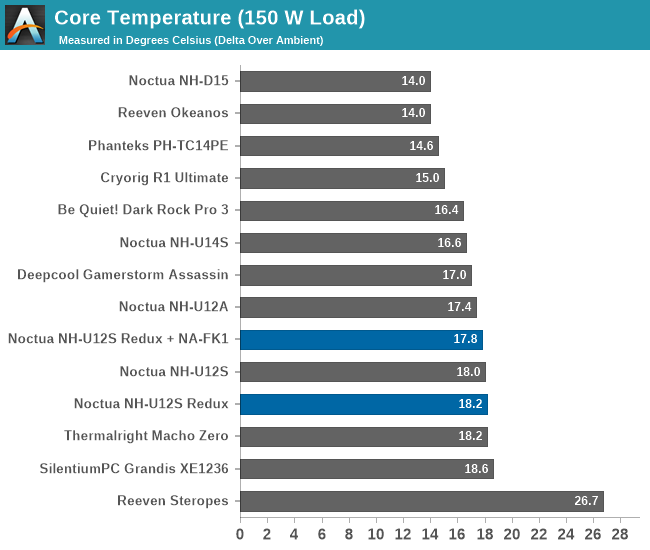
| Core Temperature, Constant Thermal Load (Max Fan Speed) |
Noctua claims that the NH-U12S Redux can perform just as well as the more advanced (and expensive) NH-U12S, just at the expense of higher noise. Our thermal testing reveals that this claim is true, as the NH-U12S Redux does perform almost identically compared to the NH-U12S. The thermal performance of the NH-U12S Redux is just a little worse than the NH-U12S without the addition of the extra NA-FK1 fan. Adding the NA-FK1 fan makes the NH-U12S Redux a little bit better than the NH-U12S but the actual performance difference is very small.
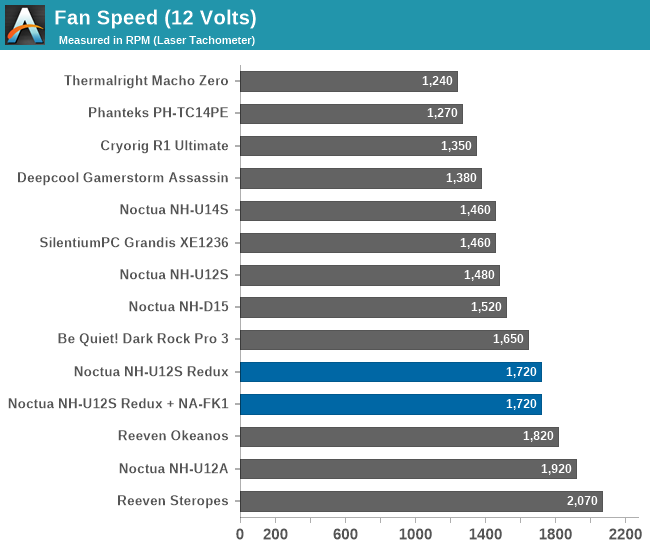
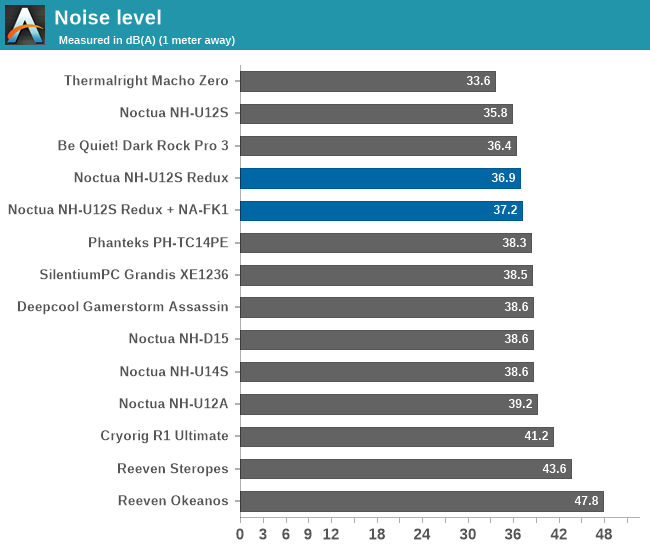
When it comes to acoustics, Noctua’s statement regarding the amount of noise generated by the NH-U12S Redux is also true. The NH-U12S Redux is noticeably louder than the NH-U12S – though not by much. With its fan running at maximum speed, the noise output of the cooler is not too high at all. Meanwhile, adding the second fan increases the noise output of the NH-U12S Redux a bit more.
Testing Results, Low Fan Speed (7 Volts)
Switching things up a bit, let's next take a look at cooler performance with the NH-U12S Redux fans taken down to 7 Volts.

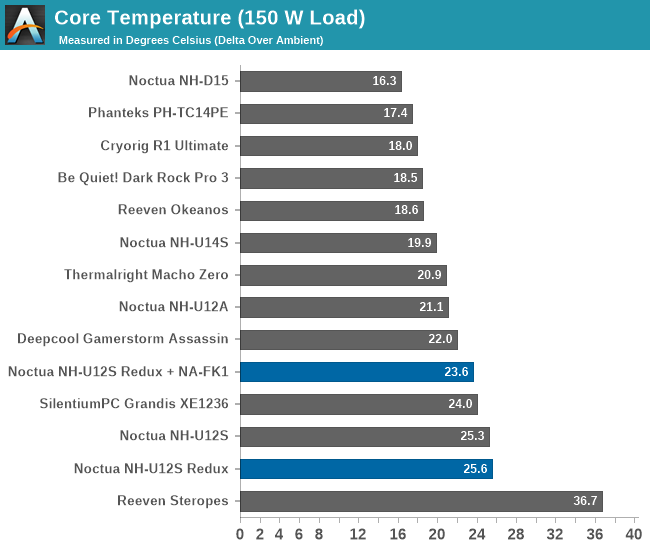
| Core Temperature, Constant Thermal Load (Low Fan Speed) |
With the speed of its fans reduced down to about 620 RPM, the NH-U12S Redux still performs almost just as well as the NH-U12S. The addition of the NA-FK1 fan here does make a difference, improving the thermal performance of the NH-U12S Redux significantly and pushing it close to the significantly larger NH-U12A.
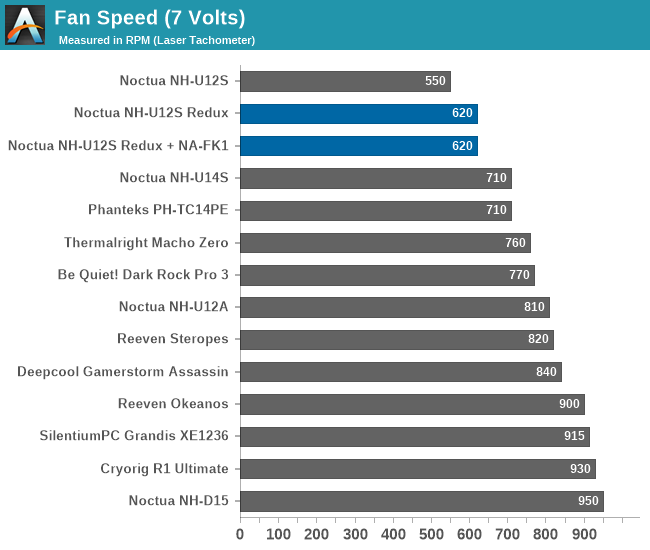
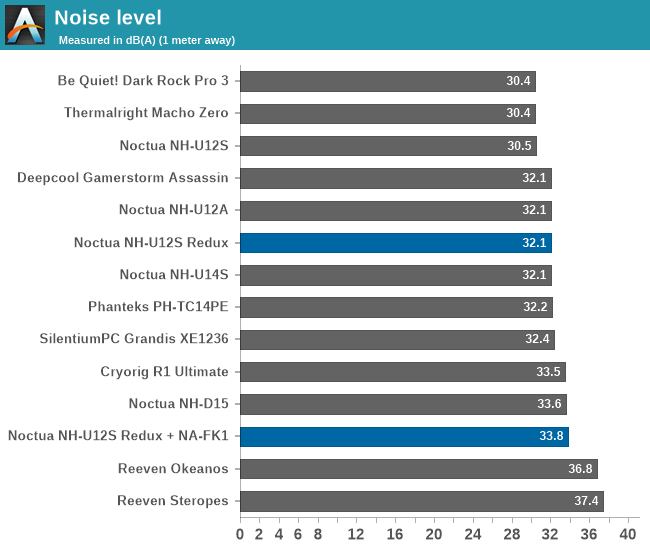
Both the NH-U12S Redux and the vanilla NH-U12S are practically dead silent under these operating conditions. The NH-U12S Redux has a noise output 1.6 dB(A) higher than that of the NH-U12S, which is technically a significant difference due to the logarithmic scale, yet on an absolute basis, 32.1 dB(A) is very low and you'd really need to focus to notice that kind of noise in a quiet room. The addition of the second fan makes the NH-U12S Redux more noticeable, but 33.8 dB(A) are very comfortable for everyday use.
Thermal Resistance VS Sound Pressure Level
During our thermal resistance vs. sound pressure level test, we maintain a steady 100W thermal load and assess the overall performance of the coolers by taking multiple temperature and sound pressure level readings within the operating range of the stock cooling fans. The result is a graph that depicts the absolute thermal resistance of the cooler in comparison to the noise generated. For both the sound pressure level and absolute thermal resistance readings, lower figures are better.
In the above chart, we can discern that the NH-U12S is indeed better than the NH-U12S Redux when both the thermal performance and acoustics are taken into account. The NH-U12S Redux does offer great overall performance though, rivaling even that of the NH-U12A under certain conditions where the fan of the latter becomes too noisy for the thermal performance the cooler offers. We can also see that the addition of the second fan makes the NH-U12S Redux capable of reaching slightly lower thermal resistance figures, though always at the disproportionate expense of noise.


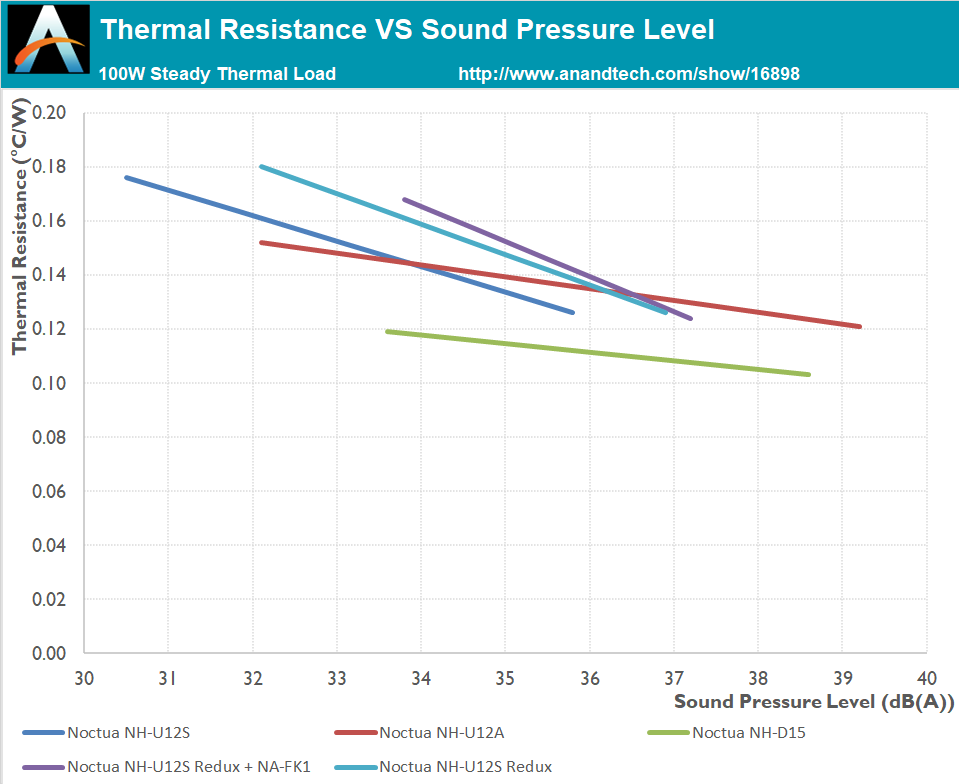








38 Comments
View All Comments
Spunjji - Friday, August 27, 2021 - link
Yeah, you're definitely outside the Prism's sweet spot at that point. I'm impressed to hear that it handles 135W at all!AntonErtl - Friday, August 27, 2021 - link
It handled even 190W above idle power consumption. Given that the Prism is delivered with CPUs that have 138W PPT, it definitely should be able to handle that. The 190W is surprising, though.Spunjji - Friday, August 27, 2021 - link
My experience with the Wraith Prism was very good, but I think you need to stick with 65W (or below) processors in order to get the best from it. It will handle higher loads than that, you just have to accept that it won't be anywhere near quiet.TrevorH - Thursday, August 26, 2021 - link
While the linked article does contain several stock coolers, are any of those available or widely used in 2021, 5 years on from that review? Are the results directly comparable with the current review? It would have been nice to include the AMD Wraith Prism in this set of results since it's not in that old article and I guess it would be nice to include whatever Intel is bundling too.kepstin - Wednesday, August 25, 2021 - link
This gets particularly interesting with things like AMD's high-end Ryzen CPUs, where even when not overclocking, a better cooler than stock might let the CPU boost to higher frequencies for longer. (Let alone the noise benefits) But that's so dependent on the particular CPU and case environment/ambient that I don't really know how you could make a useful comparison in a standalone cooler review :/A5 - Wednesday, August 25, 2021 - link
The short answer is that they're really bad. Anyone who sits in the same room as their computer should invest the $20-$50 to get a good air cooler.TheinsanegamerN - Wednesday, August 25, 2021 - link
They're fine as long as you dont put a K SKU with unlimited turbo under them. Regular intel chips are quite efficient.Spunjji - Friday, August 27, 2021 - link
I've never had a good experience with an Intel stock cooler, but I know a few people who've used them for their budget gaming systems. It depends a lot on your sensitivity to noise. Personally I hate the buzzing noise the fans on them make, even at lower speeds.Leeea - Wednesday, August 25, 2021 - link
I like the pre-applied thermal paste, great feature.I wonder if the different fan was necessary, or if they are just artificially nerfing the product? I doubt they cost any different to manufacture.
I did not know Noctua normally welded the fins, interesting.
DanNeely - Wednesday, August 25, 2021 - link
The cheap model has fewer heat pipes and poorer connections between the pipes it does have and the fins. With an equivalent fan it would preform hotter than the more expensive model; to keep the thermal performance the same Noctua used a faster - and thus louder - fan.